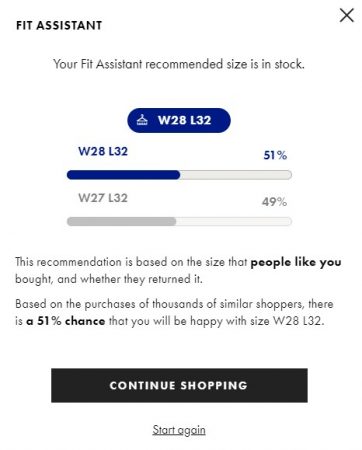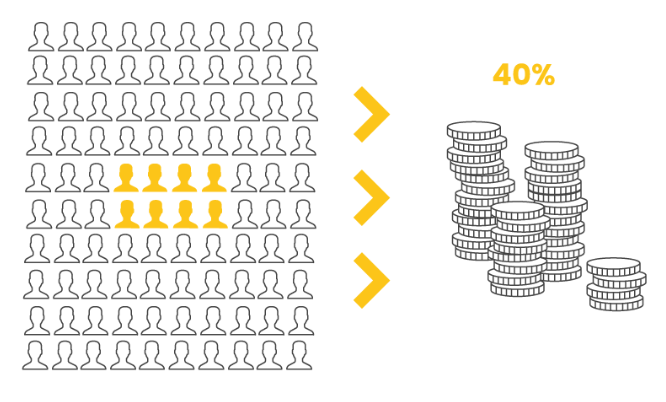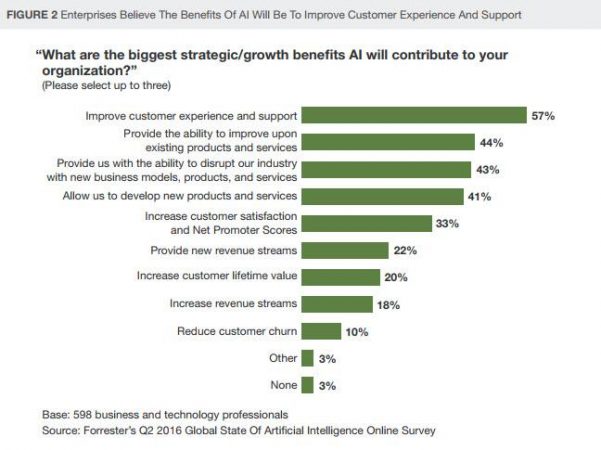Is your eCommerce business suffering from costly returns, customer churn, or margin decreases? Do you try your best to optimize prices but spend too much effort? Or maybe your online consultants are overloaded with claims and questions from customers and fail to deliver the best quality services?
If you recognized some of the challenges of your business, then it may be useful for you to know how the most successful retailers in the world manage them with the help of Machine Learning.
Come on and dive in with us into the ocean of the opportunities for your eCommerce business with ML!
11 Actionable Machine Learning Use Cases in E-commerce
To start, I’ll give you three examples of using Machine Learning for eCommerce:
- Asos managed to multiply their revenues by 300% while reducing the losses from returns by 2 times.
- Uniqlo directs customers to the nearest stores where the items they want can be bought shortly after they search from their smartphones.
- Arcbazar increased customer satisfaction with the price recommendation that supports them in their decision-making.
Big or small, most retail websites have similar challenges and goals. Here are 11 ways you can enhance your services and start growing your margins now with Machine Learning in eCommerce! We hope you’ll find these useful to you and your business.
Here is our super-list of areas where you can start implementing Machine Learning right now:
1. Smart Search to Help Your Buyers Quickly Find What They Want
2. Recommendation Engine that Increases Your Revenue
3. Price Optimization for Winning Even When You Cut the Margins
4. Customer Lifetime Value Estimation to Grow Revenue in the Long Run
5. Churn Prediction to Prevent Them Going to Competitors
6. Inventory Management to Balance Products Assortment in Stock
7. Returns that Do Not Steal Your Money
8. Chatbots to Serve Your Customers 24/7
9. AI-Driven CRM for Less Routine and Better Sales Processes
10. Fraud Detection for Eliminating Cheats and Increasing the Customer Trust

1. Smart Search to Help your Buyers Quickly Find What They Want
The challenge here is that we often can’t describe what we’re looking for. I deal with this constantly when doing my shopping. How to find something that you only saw and have no idea what is it. For example, I saw in someplace these wonderful jars and want to buy them.

Unless I do some research, I would never guess these are “DIY Star Wishing Bottle Glow Pigment Luminous Gravel Sand Particles Stones Decor”.
Another example is when you are searching for a product and by the description it is exactly what you want, however, the photos show different: some details are missing while they are in the description.
Machine Learning algorithms for search help with:
- Automatic categorization and description suggestions based on their features, image recognition, and similar items in the database.
- Automatic spelling correction
- Visual search (users upload their pictures and the system discovers the most visually similar products in stock)
- Identifying details on the image and searching them as separate products
- Voice search.
2. Recommendation Engine that Increases Your Revenue
Taking into account the user’s preferences, their previous interactions, and purchase history as well as demographics, and some other metrics, AI-driven recommenders can provide a personalized shopping experience that converts better than rule-based recommendation systems. The challenges that are solved by ML-based recommenders are:
- Product recommendations (similar items, frequently bought together)
- Assistance with listings creation at peer-to-peer marketplaces (categorization, price suggestion)
- Real-time targeted notifications
Need a recommendation system for your website?
Contact Us3. Price Optimization for Winning Even When You Cut the Margins
There are many factors that may influence the purchase activity: competition, seasonality, trends, state of the market, local demand, and even the weather. Instead of using static prices and desperately cutting them down when sales KPIs drop, businesses can benefit from ML-based price optimization. ML algorithms learn the historical data and find the patterns to predict the best prices, suggest discounts, or up-sales when it is appropriate.
4. Customer Lifetime Value Estimation to Grow Revenue in the Long Run
Analyzing the previous purchase history of your customers is a great way to define CLVs and optimize marketing expenses. There is little value in reaching out to every customer and treating everyone with the same messages and offers. Customers with bigger CLV deserve more attention as:
- They are more likely to respond to your campaigns
- It is always easier to get existing customers to come back than to attract new ones.
- Loyal customers can bring you around 40% of the company’s revenue
- Loyal customers are 5x as likely to repurchase, 5x as likely to forgive, 4x as likely to refer, and 7x as likely to try a new offering, according to Temkin Group.
Calculating CLV allows predicting the profit that a customer can bring in the future. To estimate the CLV, you can use a simple formula:
(Average Order Value) x (Number of Repeat Sales) x (Average Retention Time)
CLV can be used to optimize your marketing expenses and make campaigns more targeted. Knowing your valuable customers, you can give them better options for purchases and provide discounts. This will increase their retention and bring you more revenue even on account of lower prices, as in the long run these customers will buy more and recommend your services to their friends.
5. Churn Prediction to Prevent Them from Going to Competitors
Customer churn is one of the issues that can negatively affect sales. So, churn reduction can leverage the profit correspondingly:
“A 2% increase in customer retention (or decreasing churn) is equivalent to 10% reduction in costs.” - Emmet Murphy & Mark Murphy, “Leading on the Edge of Chaos”.
The churn is calculated by the formula:

To create a probabilistic model of churn, you need to create a pattern of behavior of customers who churned by means of analyzing their customers' data and behavior in the past (purchases, complaints, interactions, demographics). Thus, you will be able to identify similar customers and prevent them from leaving. The churn model will predict their intention one step before they do, giving you a chance to retain them. Determining the churn probability and knowing CLV, you can automate definite marketing actions for retaining customers.
6. Inventory Management to Balance Products Assortment in Stock
Having either overstock or understock of products are both unhealthy situations for your business. Machine Learning can help predict the boost or drop in sales activity, analyzing how much you need to order or produce to have enough supply to satisfy demand. As the database stores significant amounts of historical data it may connect some events and predict the trends. One of the major factors taken into account for prediction is the weather.
For example, the system of an online apparel shop may take the historical data based on the correspondence between the sales and the weather in previous periods and predict the increase or a drop of sales in similar weather according to the forecast for months ahead.
ML can help with such inventory management decisions as:
- Upselling when the systems see there is an overstock of some goods
- Predicting the demand for some products because of seasonality or trends and suggest ordering more of that product.
7. Returns that do Not Steal Your Money
25% of customers intentionally buy more items than they need if they can send some of them back to shop. This happens for fear of wrong size, inappropriate quality, or indecision. Though the return option is a great relief for the customer, they don’t realize how much retailers lose on each returned product.
That is because the returns inspection process takes many steps such as cleaning, repackaging, and preparing products for sale. And if the product is returned in bad shape, it may be unsellable. The sums lost on returns by one retailer are twice as big as delivery costs!
Providing ML-based solutions like virtual dressing rooms, size fitting tools, and personalized recommendations can significantly reduce return rates, while increasing customer satisfaction.
8. Chatbots to Serve Your Customers 24/7
One of the most obvious ways to use ML in eCommerce is chatbots. They learn user profile information and previous customer behavior to provide personalized answers that increase the chances of conversion. They work 24/7 and are able to solve most routine tasks such as:
- Answer customers’ questions
- Redirect claims to the right departments
- Recommending products
- Collect payments
- Place orders
- Schedule and track deliveries.
9. AI-Driven CRM for Less Routine and Better Sales Processes
Managing CRM can be time-consuming when you need to enter and edit all the information manually. Switching ML may ease a part of this burden by:
- Automatically scheduling meetings, sending follow-up emails, assigning tasks
- Retrieving valuable information from emails, messengers, and calls and creates user profiles, makes notes, schedules events
- Predicting and prioritizing leads that should be focused on first
- Suggesting sales reps the best next actions on the sales funnel
- Providing business intelligence: sales planning, revenues, and profits predicting.
10. Fraud Detection for Eliminating Cheats and Increasing the Customer Trust
eCommerce suffers tremendously from fraud and the most common cases are when:
- Someone uses a stolen credit card, buys products, and then returns them
- Hackers gain access to your customer database
Each time this happens you lose money, trust, and customers. All these resources are hard to refund. Collecting in your database such data as device type, location, the time zone can help identify abnormal activities that differ from previous customer behavior:
- The customer spends an amount that is much larger than normal
- Shipping address differs from the billing address
- Several orders to the same address with different cards
- Unprecedented international orders
- Malicious returns (when customers buy the products and make a return, sending back the fake items)
- Fake reviews
In any suspicious case, the system may ask for online identity verification (confirm the order by email, phone, or another way). ML perfectly identifies and flags suspicious behavior and creates patterns. For example, by identifying the truthfulness of reviews the system can analyze such characteristics as language, IP address, how often user writes reviews, what rating he/she usually submits, whether the user really purchased a product or service, how many days since the purchase, and some others.
Why ML is better for fraud detection than rule-based programming?
| Rule-based fraud detection | Machine Learning fraud detection |
| Finds only programmed scenarios | Able to catch implicit cases |
| Needs a lot of human effort for listing all the possible scenarios | Able to automatically predict the scenarios using already existing data |
| Needs constant verification and updating of rules | Evolves with each new defined pattern in real-time |
11. Making Logistics Cost-Effective
If you deal with large volumes of delivery, ML can automate warehouse operations and shipping processes that usually take a significant amount of manual effort and eat your budget. ML allows for automating and analyzing such tasks as:
- Fleet management to be aware of the schedule, fleet technical state to prevent overlaps
- Real-time orders management to schedule wisely
- Tracking fuel consumption to cut expenses and reduce CO2 emissions.
- Optimize the delivery routes to reduce empty miles and save time and fuel
- Real-time tracking of product location to quickly react on route deviations
Benefits of Using ML for Your Business
Who in the eCommerce industry doesn’t dream of an ever-growing number of satisfied customers and revenue that increases in geometrical progression? Here are the benefits of Machine Learning in eCommerce:
1. Increasing Customer Satisfaction and Retention
Nobody will deny that it’s easier and cheaper to keep relationships with the existing customers compared with attracting new ones. At the same time, loyal customers are vital for your sales increase and promotion. Retention and acquiring new customers are solved differently, but the only common thing is that both cases will benefit from enhancing the customer experience
57% of 598 business professionals surveyed by Forrester highlighted improving customer experiences and support as the most significant benefit of Machine Learning.
Why is it important to take care of CX? Because it directly influences sales activity.
According to Accenture research, 81% of consumers agree to pay more for better services and 52% of customers say they would take their business to a competitor offering a better customer experience.
Using ML for hyper-personalization recommendations, search optimizations, virtual customer assistance, accurate retargeting to classified groups of customers, and fraud detection allow for improved customer experience and retention.
2. Growing Sales and Marketing Effectiveness
By now you’ve most likely already noticed that many marketing techniques that worked several years ago no longer have any impact at all. Marketing budgets can be real money pits unless you learn to predict trends and adapt your strategy.
Machine Learning allows your business to optimize prices by changing them dynamically without loss in margins, predict customer churn, and make marketing more targeted for increasing customer lifetime value and retention.
3. Automating Back-Office Tasks
There are a lot of routine tasks that simply do not allow your employees to focus on more challenging and analytical jobs. Managing warehouses and shipping to reduce operational costs and losses from returns, answering customer questions and document management can be easily delegated to Machine Learning.
4. Detecting Fraud and Protecting Customer Data More Effectively
Why is detecting fraud so important? Because this is a trust-building aspect! And you will never return a customer who lost faith in your service. Customers trust you with their valuable financial information when creating profiles. So, stopping fraud is a top priority and Machine Learning for detecting eCommerce fraud allows you to predict malicious behavior and save your reputation.
Need to implement a Machine Learning solution to increase your business efficiency?
Contact UsMachine Learning in eCommerce: Case Studies
Now that we’ve learned what we can do and why it will be valuable to prove the theory in practice and glance at the real-life examples that already work. Here are some of the Machine Learning eCommerce examples...
Arcbazar: Sophisticated Price Recommendation System for Increasing Customer Retention
One of the eCommerce machine learning case studies is our client’s recommendation system. Greenice is a long-term technical partner of Arcbazar, the largest competition platform for architects and designers in the world. Recently, we have created an ML-based recommendation system for them to enhance their customer experience by suggesting a price for competitions.

Using historical data of more than 1,5K successful projects, the system understands the customer intent and proposes the competitive and adequate award that customers should pay to the best project selected during the competition.
HelloAva: Personalized Product Recommendations For Enhancement of Customer Experience
HelloAva is a platform for personalized skincare that is aimed at picking the right products for specific skin types. To get recommendations, customers need to create a user profile where they are asked to fill out a quiz about their skin. The ML system analyzed the data and assigns an advisor picked by aestheticians from a bank of 2,000 products and based on dermatologically-driven data. 
BooHoo: Robust Search for Better Product Discoverability
Boohoo switched a visual search functionality to their mobile website which is based on image recognition. Customers upload their images and the system looks through the similar products in stock.

Even on the testing stage, the numbers were impressive. The conversion rate increased by 100% compared to cases when people did not use the new feature. The pageviews increased by 135%. And an average order value grew by 12%. This is how only one ML-based feature drove an increase in sales.
Asos: 3x Value by One ML Solution
Asos, one of the largest online fashion retailers, implemented ML into their website to help customers determine the right size more precisely. They called its new sizing tool the Fit Assistance. Customers need to complete a quiz about their height, weight, age, hip and waist measurements, preferred fit type (tight, average, or loose), and their size in popular brands.

According to all this information, the system can determine the size at once. The algorithm is based on the sizes in the database that were previously chosen by people with the same measurements and whether they returned the product or not.
Asos managed to achieve a triple benefit:
- Increase of purchases by 300% using a chatbot
- Returns reduction by recommending the right size
- Increased customer experience when the risk of getting the wrong size is minimized
Uniqlo: Voice-Activated Search Assistant for Sales Stimulation
Uniqlo is a famous Japanese retailer of casual clothes loved by people all around the world. Recently, they have launched a Uniqlo IQ app that provides a voice concierge service for customers. Users can search the items making queries by voice, text, or images. The digital assistant is able to recommend outfits for any occasion, using personal information, past customer’s behavior, and even daily horoscopes. With these recommendations, customers are directed to the nearest store where they can buy all the clothes.

How to Apply This to Your Business
Whether you feel that your business is suffering from decreasing sales, customer churn, big losses from shipping and returns, and at the same time your team tries their best at retaining customers and attracting new ones, it may be a turning point for you to switch to Machine Learning!
Machine Learning in the eCommerce industry can help you understand your audience better to make marketing more targeted, reduce operational costs, and give discounts without cutting margins.
We gave you 11 actionable Machine Learning use cases of where you can implement ML now, and see the results in the near future.
It makes little sense to go on collecting data about your customers, without analyzing it. We can help you find a better usage of the data to enhance customer experience and increase your profits!
Inspired with ML Use Cases and want to implement them in your system?
Contact UsRate this article!
5
 PHP Development
PHP Development Laravel
Laravel Yii
Yii





Comments (0)